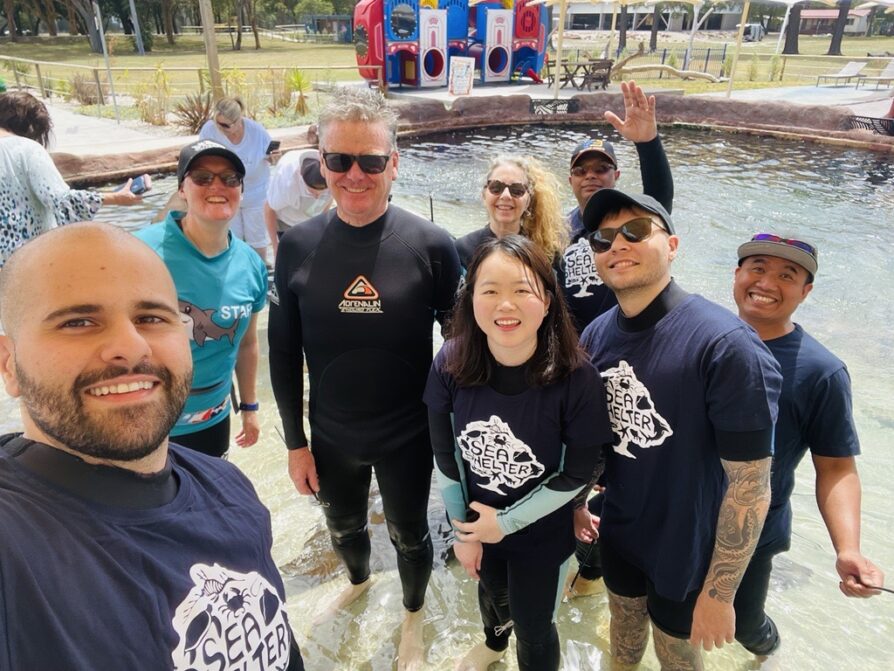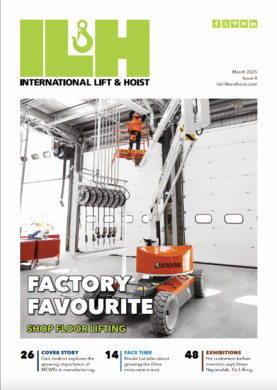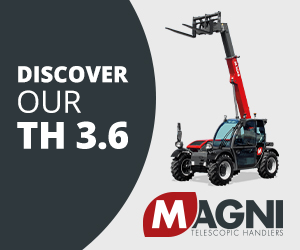)
Harnessing the storm
Embracing environmental issues and modern technology, Richard Crake, chairman and managing director of Pacific Hoists talks to Maria Hadlow about what can be achieved when you turn challenges to your advantage.
Few companies have the facility to invest during a crisis, even fewer have the nerve, but that is just what Pacific Hoists has done, not once but three times under the leadership of chairman and managing director Richard Crake.
Richard had been with Pacific Hoists for just four years when the effects of the Global crash hit. In 2009, as Australia went into crisis, Richard decided on three things: to grow the business; to invest in leading technology and to become operationally excellent.
“It was these goals and their delivery that carried us through – we experienced rapid growth at a time when several of our customers went bankrupt and others, that struggled, were acquired,” he says.
Having come through this first crisis in extremely good shape, the industry was fundamentally changed. About five, six years ago, the mining boom ended and capital investment in the mines, building mines and gas plants came to a rapid halt.
“Many large organisations restructured completely, and many others went into very serious loss positions,” says Richard. “We needed to change the way we worked and, at that point, I realised that those three things – grow the business, invest in leading technology and become operationally excellent – would not be enough.
“I’ve always been interested in the environment and social responsibility. In line with that, we refined our strategy and put two things above those initial three goals. Those were: environmental care and social responsibility.”
Covid-19 was the third in a succession of outside crises. Richard’s plan to keep the business growing throughout an unpredictable period, included making three major investments and becoming carbon neutral.
“I decided we were going to become carbon neutral by 2022,” says Richard. “Part of that work was an ongoing programme to reduce carbon emissions, but where we couldn’t reduce – we are an importer, so we are always going to be shipping and freighting – we needed to offset.
“To offset our carbon footprint, we are focusing our activities on indigenous culture, marine environment and land environment, which encompasses our environmental care and social responsibility goals.”
These were all courageous moves, but Richard puts it down to his competitive streak, “I am extremely competitive,” he says with a good deal of humour. “If I am told I can’t do something or an external, uncontrollable event tries to stop me I am even more determined.
“When you are steering a boat through a storm – set the course, trim the sails and embrace the experience.” Richard is definitely at the helm in his sou’wester.
“When you say, following the global financial crisis, that we are going to grow, it changes the psychology in the company,” Richard explains. “If the market shrinks, we’ll get more of what’s left – and we are going to invest.”
“One of the advantages of being a debt-free business is that we can invest. Some of the largest investments have been made in crisis time and that gives people the confidence to achieve the goals you set.
“It’s important to demonstrate your confidence in the business. During Covid, we have made a six-figure investment in the online portal and in 16 weeks we have built the first integrated service/calibration/repair small tool asset management program in our industry called ‘Shield’. We already have more than 6000 assets in management and have secured two major mining contracts. We didn’t have any of that prior to Covid. In the eight months of Covid, we have generated the best sales and financial performance that the company has ever had.”
Shield has continued to be an important asset for the company and has helped grow the business in the areas it is targeting. Covid may have been a pivoting point for Pacific Hoists, but invigoration has continued and once again a record year has been achieved for the group.
Richard’s background is not in the lifting industry. His work history began straight from school at a large automotive manufacturer in the UK and while he was there, he studied industrial chemistry and metallurgy to gain a qualification in Industrial Chemistry and Marketing.
After one or two different jobs, Richard settled at a division of Unilever – Lever Industrial in the UK, which specialised in soaps and detergents. Following 19 years working in London then Paris, Richard was located in Australia in 1993. It was then that Richard first met Michael Herbert, the son of the owner of Pacific Hoist who was his neighbour and became his friend.
After a few years, Richard went back to the UK for seven years then, in 2003 returned to Australia. By then Michael Herbert was the owner and managing director of Pacific Hoists and the two men had maintained their friendship. Tragically, following an illness Michael Herbert died at the age of 44.
So, while still working at Unilever, Richard gave his spare time and evenings to help out at Pacific Hoists. After eight months, he joined the company full time as the chairman and managing director.
“When I joined it was just Pacific Hoists Australia – now after 16 years with the company, we have four businesses and are market leaders in hoists and hoisting equipment in Australia and New Zealand.”
Richard admits that it was a bit of a culture shock after working in the health care sector. “At first I couldn’t even tell the difference between a hoist and a winch,” he laughs. “I was used to a big organisation and large customers, when I came to Pacific Hoists there were lots of small distributors and very few innovations.
“At the beginning I found it very difficult to get to grips with. It was a good business with some fantastic people with long service in the company, but I was shocked by the lack of technology: laptops and mobile phones – the things we take for granted today and the luxury of which I was used to at Unilever.
“It was also a difficult time for the business, Michael had been ill for some time before he passed away and the country was recovering from effect of the 2000 recession. That had a dramatic effect on the Australian Dollar exchange rate. When 100% of your product is imported, fluctuations on exchange rates have a massive effect.
“The industry I’d come from and the one I had joined were chalk and cheese in nature and in size,” he says.
“When the global crash hit it was apparent to me that being an importing wholesaler with a value-added repair and inspection business made us vulnerable,” says Richard. “I took the opportunity to completely change the way the company worked in terms of IT and structure. I wanted to be able to access all information from anywhere, to currency trade if we had to. So, in 2009 we took things onto the cloud.”
“During that period when it was very difficult for everybody in the market, we invested heavily in IT and technology.”
Richard had already made sure all the training systems and work manuals had been put on the cloud. “They were all big paper manuals,” says Richard “The whole back wall of my office was one big filing cabinet full of folders, now there is not a single sheet of paper in my office.”
Richard believes that technology is the future when it comes to supplying an excellent service. “Take for example onsite servicing for the mining industry: paper audits are inefficient and can be subject to misuse – in addition, the process is not good for the environment,” he says.
“With our system you can scan in a code then talk into your mobile phone. All data can be spoken into a phone, to report an incident, for example, you can click on a code and through a cloud-based, workplace health and safety management system you could speak or video the incident and the response can be in seconds.
“We employed a robotics engineer and invested in machine learning so machines can communicate with us online and we can see what the equipment is doing, how it is being used, whether it is too hot, too wet or if termites are eating the wires.
“Remotely we can alert the customer, stop the equipment from being used or put it in limp mode. We are investing heavily in our own design so equipment can communicate – this is already available in industry for larger pieces of equipment, but we are designing for smaller devices.
“It could also help our customers find out what their carbon footprint is,” he says.
Pacific Hoists’ own carbon footprint is massively reduced – the company met its own carbon neutral goals over a year ahead of plan.
“When we started there was no easy way to calculate carbon footprint,” says Richard. But we knew what burned carbon and we knew if we burn up a lot of electricity and use a lot of cars, our footprint is higher.
“So we did a few things immediately: halved the motor vehicle fleet in a year, reduced our land footprint by 35% by closing two of our offices and merging them into other offices. We must have reduced our carbon emissions by 30% before we went into full measurement.
“Then, in April last year we worked with an auditing company and, using UK we audited the whole company. This included the food we ate, how people got to work, vending machines – every detail of the company was included to establish our carbon footprint.”
Carbon neutrality is achieved in two ways; reducing the footprint and offsetting the carbon. For both to be successful it was important to include all the staff in the project. “You have to bring people along through empowerment and communication,” says Richard. “Very early-on we took the whole staff to an Island off Queensland for two to three days of presentations, fun, and teambuilding to explain what we were trying to achieve.
“The offsetting projects are a priority at board and operational level, but in the form of bushfires and floods it’s real to everyone and they are fully engaged. It is important to give back – we are a very successful debt free business so wanted to give something back,” says Richard.
“Originally we set up four projects with the plan to focus on these as a priority for the business.
“Before Covid came, I had met with a couple of indigenous elders in WA and was planning for staff to go to indigenous communities. It was important to meet with the people and understand the real challenges they have. We were not there to hand out pencils and paper. We were there to work and help, to stay in the community and learn about the indigenous culture and the environment before entering into a programme of doing things.
“We have worked on a land environment project in New Zealand; a back burning project with indigenous people in Northern Queensland, which helps prevent the spread of bushfires and protects the ecosystem and reforestation of the wheat belt in WA. We use these projects, which are gold carbon sequestration projects to offset our carbon footprint.”
Involvement in the community also comes by becoming involved in charitable fundraising. Chris Golpashin, Pacific Hoists’ chief marketing officer says, “Much of the fundraising is led by Richard – he is a real philanthropist and loves doing it and his enthusiasm is contagious.
“One of our most recent fund raisers was ‘Walk for a cure,’ where you had to walk 86km in a month for children’s cancers. Everyone in the company seemed to be on a fitness kick so we got involved with the company giving AU$500 for every employee that did it. We raised AU$18.900.
“We are actively supporting children’s cancer charities in New Zealand and breast cancer charities in Australia, but we like to get involved if a team member has a particular cause they want to support and we can find a way of raising money,” says Chris.
In terms of the environment, the travel restrictions placed by the Covid pandemic meant that the company’s plan to work with a community protecting and trying to re-establish the flat-back turtle population in North West Australia were put on hold. Subsequently Pacific Hoists is engaging with the Sea Shelter organisation based in New South Wales.
Whatever the problem is, Sea Shelter aims to rescue any marine fish or reptile in the Port Stephens area with the help of a dedicated team of volunteers and vigilant public eyes.
Already the team at Pacific hoist has attended a staff education programme where all staff learned about marine conservation. Part of the experience included swimming with the sharks that are housed in huge, naturalistic enclosures. The company is planning long term support for the organization and the work it does in protecting and promoting the ecosystem.
Being involved with organisations such as Sea Shelter and charitable initiatives does not contribute to carbon neutrality but it sets a tone of social responsibility which chimes with Pacific Hoist ethos.
“We will be the first carbon neutral company in our industry in the world,” says Richard. “And the first carbon neutral supplier to most of our major corporates in Australia.
“Our main Sydney head office is carbon positive. With the largest solar array we could put on the building, it is contributing electricity back to the grid,” says Richard. “And the New Zealand operation is using hydro power.”
All the company vehicles have been changed over to hybrids.
Pacific Hoists’ employees have been provided with information as to how their own actions impact the carbon footprint. Many have chosen to reassess their diets: eating less meat and more vegetables and are conscious of the methods they choose to travel to work. “Working from home, a necessity because of Covid, is also being adopted about 50% of the time, because of its environmental benefits” says Richard, “And the vending machines have been replaced with food baskets, which offer free, healthy snacks.”
Improving the carbon footprint of a company is a journey, “If you make it a primary focus it will happen,” he says. “But you can’t stop, it has to become part of the business and a continual process. There isn’t a cut-off point. It is not about KPIs its about continuous actions and activities.”
Pacific Hoists’ success in developing carbon neutral strategies has led to Richard’s being invited to address and advise some six major global businesses becoming carbon neutral.
Just as carbon neutrality looks to the future of the environment and each individuals’ healthy survival. Richard’s succession plan for Pacific Hoists focuses on a vibrant future. The company’s junior management team all joined before the age of 30 and Richard encourages them to develop their ideas.
“I am now the second oldest in the business and I have told the junior management team only to consult me if they feel they need to.
“Many modern businesses are designing lifting out of the process – you design out the risk and you design out the cost. In the Tesla factory, for example it is all robots – no chain hoists. We have to adapt and embrace the changes. We need to be able to diversify and younger people are more flexible and adaptable.”











